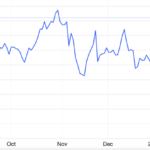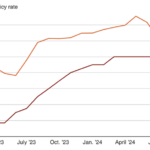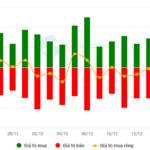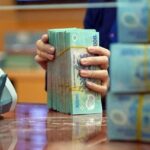Speaking at the Data Talk – Macro Insight program, Mr. Tran Ngoc Bau, a finance and economics expert and CEO of WiGroup Economic and Financial Data Company, shared his insights on the current economic landscape in Vietnam and globally.
According to Mr. Bau, the US Federal Reserve has maintained a stable interest rate policy since late 2024, amidst the new policies introduced by President Trump. This has prompted investors to question how the Fed will respond to these changes.
Turning to Europe, the region has witnessed six consecutive interest rate cuts, and the question now is whether there will be more cuts ahead. Economic data suggests a recovery, and some researchers have confirmed that the European economy has likely bottomed out. This indicates that in upcoming meetings, the European Central Bank will likely taper its monetary policy stimulus.

Screenshot
Domestically, the State Bank of Vietnam (SBV) has taken decisive actions on both the interbank and retail markets. In mid-February, the SBV reduced the interest rate on treasury bills and temporarily halted their issuance, indicating their intention to keep interbank rates very low or even allow them to fluctuate within a wider range of 0-4%. This was a proactive decision by the central bank.
Additionally, the SBV reprimanded commercial banks for raising deposit rates recently and instructed them to reduce costs to lower lending rates. As a result, deposit rates have decreased rapidly.
“Fortunately, during this period of SBV’s actions, the USD Index (DXY) weakened significantly, reducing pressure on exchange rates,” said Mr. Bau.
According to Mr. Bau, Vietnam’s economy still has a long way to go to achieve its 2025 growth targets, and more stimulation is needed. This requires more aggressive fiscal and monetary policies, including interest rate and money supply adjustments. This is why interest rates have become a hot topic again after a period of calm.
Mr. Bau predicts that the SBV will definitely cut interest rates, and the speed of these cuts will depend on capital outflows. These rate cuts will apply to both the retail market (resident market) and the interbank market.
Specifically, the first step will involve adjusting the interest rate on treasury bills, followed by Open Market Operations (OMO) rates, and then other rates (likely the ceiling rate for deposits with terms of less than six months). Finally, more stimulating rates, such as the refinancing rate and the overnight funding rate, will be adjusted.
“This is a journey that needs to be taken step by step, and the SBV is doing a good job so far,” said Mr. Bau.
Mr. Nguyen Hoang Linh, Director of Research at Vietcombank VCBF Fund Management Company, added that in Vietnam, the transmission of interest rates from the interbank market to the resident market has certain limitations and is not entirely immediate. However, when the conditions are right and external risks subside, the SBV can reduce the operating interest rates, which will immediately impact investors’ psychology. The stock market may receive this news positively.
“However, we should note that these are developments in the stock market, and it is not certain that borrowers will immediately benefit from this,” said Mr. Linh.
Inflation Management Must Stay Grounded in Reality from the Start
In 2024, the consumer price index (CPI) rose by an average of 3.63% compared to 2023, remaining below the target set by the National Assembly. This marks a decade of Vietnam’s successful inflation control, with an average rate below 4%. Experts suggest that maintaining a CPI increase of around 4.5% in 2025 to support a substantial 8-10% growth will be a challenging task, requiring decisive and meticulous management from governing bodies from the get-go.
Gold Slides After Powell Says No Rush to Cut Rates
The Fed’s meeting spurred a rise in Treasury yields and the dollar, exerting downward pressure on precious metals.
The Market Pulse: Is the Risk of Adjustment Rising?
The VN-Index witnessed a significant decline, forming a bearish Falling Window candlestick pattern and dipping below the Middle Bollinger Band. This suggests a potential shift in market sentiment. The volume also spiked above the 20-day average, indicating heightened investor anxiety. The Stochastic Oscillator is firmly in oversold territory and continues to signal a sell-off. If the MACD also turns bearish in the coming days, the likelihood of a more pronounced correction will increase.
Prime Minister Requests SBV to Implement Stronger Measures to Reduce Lending Rates
Prime Minister Pham Minh Chinh has issued Official Dispatch No. 135/CD-TTg on December 16, 2022, emphasizing the continued strengthening of measures to regulate interest rates and credit.





















